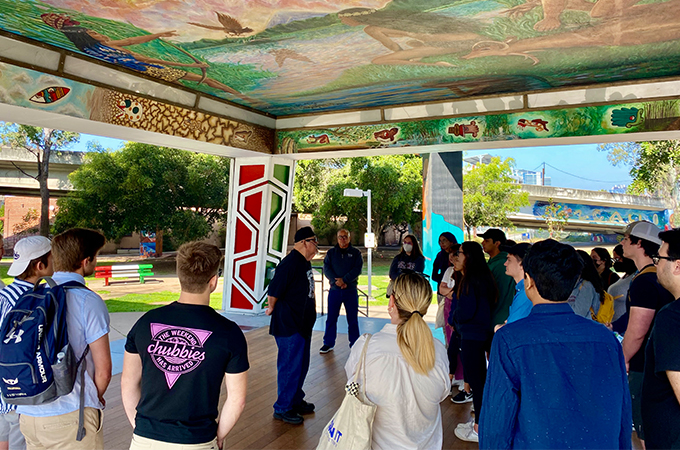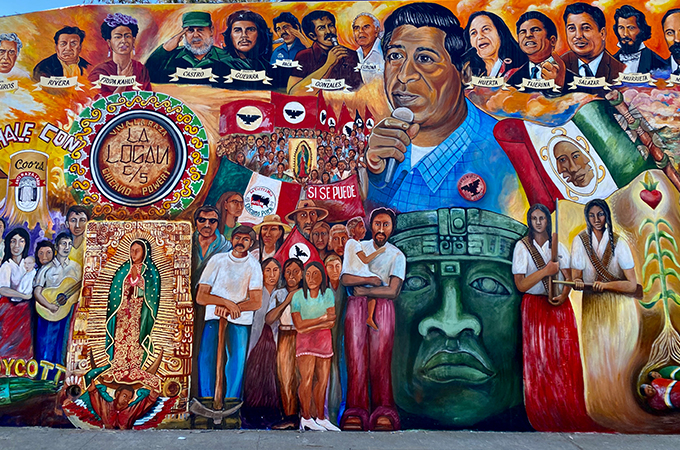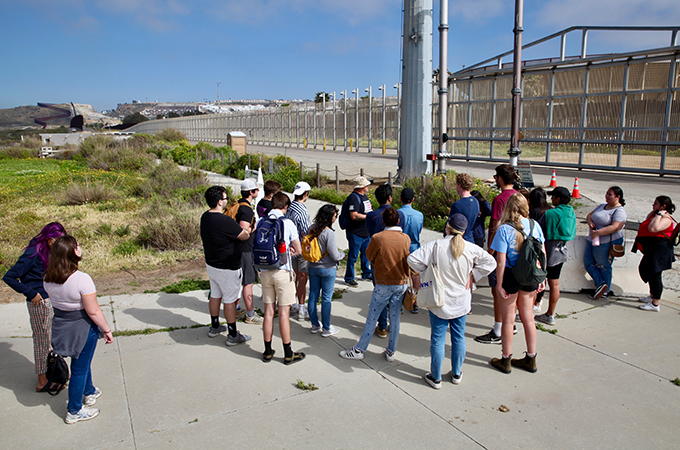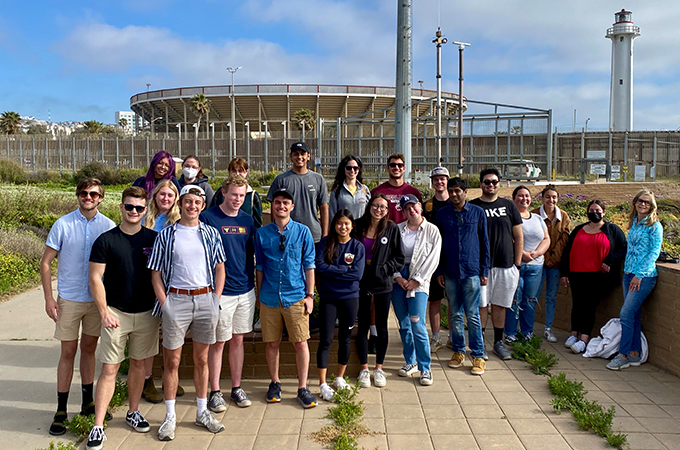What does it mean to belong? Who is a citizen? Students discussed these questions and other ideas in Professor of Political Science Renée Van Vechten’s spring semester Immigration Politics and Policy course. To provide context for their conversations, Van Vechten added a new feature to the class: a trip to the U.S.-Mexico border.
“We look at concepts of citizenship, borders, and boundaries, and the concept of illegality,” she said, recalling the content of the course. “But there’s no substitute for seeing these concepts in action. When it comes to immigration, it’s essential to comprehend the human dimensions of this intractable public policy issue. It’s too easy to reduce people to numbers or statistics.”
While Van Vechten has taught the course several times, this was the first time she incorporated a trip to the border. Throughout the semester, students engaged in hands-on projects informed by what they were learning and welcomed guest lecturer Samantha Acuña ’18, a political science and government doctoral candidate at the University of California, Los Angeles.
“The course incorporates a community service element. The students worked on class projects that would connect citizenship services to the University,” Van Vechten said.
As the Fletcher Jones Endowed Chair in American Politics & Policy, Van Vechten utilized discretionary funds from the endowment to support the trip. These resources were leveraged by additional funds from the College of Arts and Sciences Dean’s Office and David Boies Endowed Chair of Government Professor Art Svenson. Van Vechten partnered with Via International, a nonprofit organization that leads educational border immersion trips, to plan the itinerary, which included a visit to San Diego’s historic Chicano Park, a walk through the Tijuana Estuary to the border, and ended with a class dessert at her house.
Exploring San Diego history
Chicano Park is home to the largest concentration of Chicano murals in the world and is located beneath the San Diego-Coronado Island bridge in Logan Heights, the city’s oldest Mexican American and migrant neighborhood. More than 80 paintings appear throughout the park’s seven acres. On the day Van Vechten’s class visited, several muralists were at work.

Rigo, the group’s tour guide, explained the park’s history, including a story about residents forming a human chain for 12 days in 1970 to save the area from development by California Highway Patrol. Their occupation led to the official formation of Chicano Park in 1971. In 2017, the location was designated as a national historic landmark.
“Our tour guide was young when the park was first formed and was there when they were blocking the California Highway Patrol’s construction. Hearing the history from him and being able to see and learn about what the murals meant was incredibly impactful,” Noah Moeller ’23 said.
Many of the muralists had lived in the neighborhood for decades and were eager to share their stories with the students. Some even invited students up into the scaffolding to get a closer look at their paintings.

“I’m from San Diego and I was really excited to see a different aspect of my hometown,” Shira Griffith ’23 said. “Getting to go to Logan Heights and Chicano Park and learn about the history of the park was really cool.”
Van Vechten, who is also from San Diego, agreed. “[Chicano Park] is a San Diego treasure,” she said. “Considering the amount of work that has gone into building and maintaining the park for 52 years, it’s awe-inspiring to see how it has developed into a dynamic work of art.”
Learning how policy affects people
After lunch, the group hiked through the Tijuana Estuary Nature Preserve and gathered near Friendship Park at the U.S.-Mexico beach border. Before the COVID-19 pandemic, the park served as a meeting place for friends and family members on either side of the border to gather and talk to each other. Robert, the tour guide from Via International, posited that the park would reopen soon.
Robert also shared his story with the group, which included being held in a detention center for 18 months and then being deported from the United States to Mexico, where he had to stay for eight years. Both Van Vechten and her students noticed the heavy militarization of the border’s north side. Just over the wall in Mexico, families were enjoying the beach.
“One of the concepts we’ve talked about in class is border security policy,” Van Vechten said. “We could see the dichotomy of the two nations at the dividing line—there’s a double wall with a buffer zone and officers patrolling on one side, and on the other, people are having parties, flying kites, enjoying their Saturday, and frolicking in the water.”

Leading up to the trip, students examined immigration law and the driving factors behind what it means to establish a body of rules that are designed to either keep people out or welcome them. When the border patrol border was created in 1924, a race-based quota system was also implemented, which had lasting impacts on United States demographics.
The journey to the border provided students with a real-life application of concepts they discussed in the classroom and emphasized the human experience. “Being taken out of a theoretical context and being confronted with a practical one, where there are real people, is an essential part of the learning process. You can certainly learn about immigration by reading about it, but theoretical concepts take on a powerful meaning when people tell you their stories,” Van Vechten said.
The experience was thought-provoking for students as well. “The class trip to the border was by far the most moving as well as motivational aspect of the whole course. Visiting the border and hearing from those who have experienced first-hand the failures of the immigration system brought the course materials to life in a way that I cannot effectively put into words,” read one response from a student after Van Vechten collected feedback through an anonymous form. Other reflections called the experience “absolutely essential” and helpful for seeing “the effects of policymaking in real life.”
Mary Tanouye ’22, another participant, said of the trip: “It opened my eyes to how much the U.S. focuses on keeping people out. Seeing that there was no security on the other side made it really apparent that our country spends a lot of money on military and security, and it made me think about why.”
Learn more about studying political science or other subjects at the U of R.






